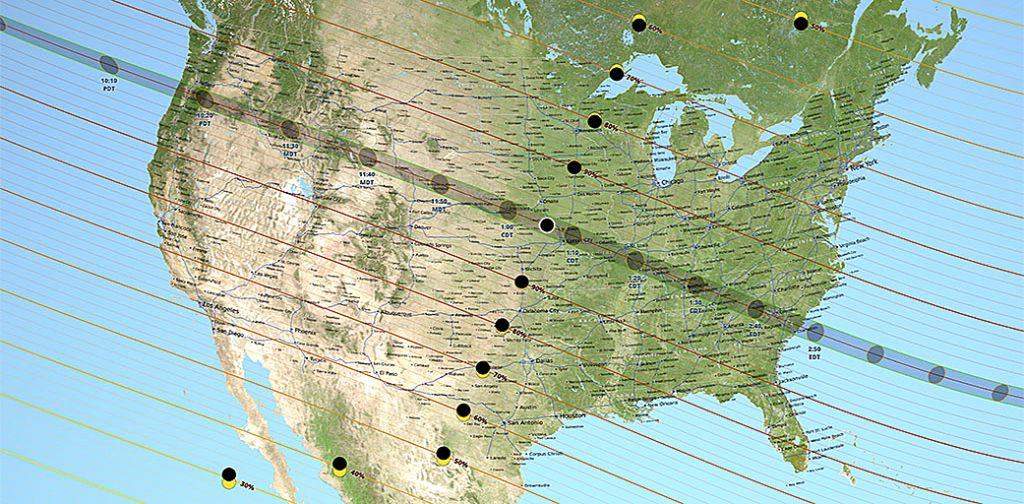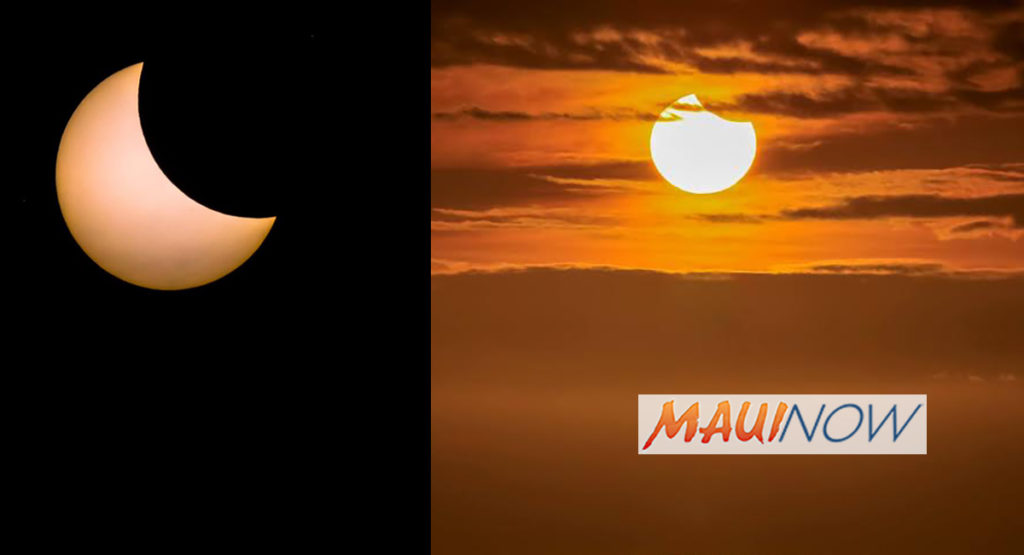Total Solar Eclipse: Partial View Over Hawai‘i Begins at Dawn
*Click here to watch a Live Stream of the eclipse from NASA.
*Click here to see a slideshow of images from across Maui.
https://www.facebook.com/mauinow/videos/10156571485709867/
Sky watchers in Hawaiʻi will turn their eyes to the skies on Monday morning, Aug. 21, 2017, for a partial view of the Total Solar Eclipse that will make its way across the Mainland US. Hawaiʻi will actually get a glimpse of the event before it becomes total with about one third of the sun’s disk blocked by the moon, according to astronomers.

The total solar eclipse of Aug. 21, 2017, stretches across the U.S. from coast to coast, providing scientists with a unique opportunity to study the eclipse from different vantage points.
Credits: NASA’s Scientific Visualization Studio
That will occur as the sun rises in Honolulu at around 6:20 a.m. on Monday, Aug. 21. “For the next hour, viewers using safe viewing devices (and a clear eastern horizon – the sun will still be low in the east, in this hour after dawn) will see the moon slowly uncover the sun. By 7:25 a.m. in Honolulu the eclipse will be over,” according to astronomers with the Bishop Museum’s J. Watumull Planetarium.
“As this eclipse ends at 7:25 HST on Aug. 21 in the islands, it will be getting underway on the North American continent as the shadow of the moon races across our planet. 7:25 a.m. HST is 12:25 p.m. Central Daylight Time in Nashville, for example, and at that time the partial eclipse will be underway in Nashville; the eclipse in Nashville goes total at 1:27 p.m. CDT on Aug. 21, which is 8:27 a.m. Hawaiʻi Time… ,” according to information compiled by the Planetarium.

PC: partial solar eclipse that occurred from 4:33 p.m. to 6:33 p.m. on Tuesday, March 8, 2016. File image over Hawaiʻi: Chris Tinker
According to the J. Watumull Planetarium, a total solar eclipse occurs when the moon completely blocks the Sun which reveals the Sun’s outer atmosphere – the corona. This is considered a rare event for those in the US, and Planetarium staff note that those in Hawaiʻi will actually have to wait until 2106 to view a total solar eclipse in the islands.
The last total solar eclipse visible in the continental US reportedly occurred in 1979, and the next one will not take place until 2024′ but event that one will be viewed as a partial eclipse for most of North America.
Monday’s event is being called “The Great American Eclipse,” because it will pass across the center of the continental US. Cities along the path of totality include: Salem, Oregon; Nashville Tennessee; and both Columbia and Charleston, South Carolina, according to the Planetarium.
Parts of Oregon will be the first to see the total eclipse starting at 10:16 a.m. PDT on Monday, Aug. 21, with the event to be in total form for just under two minutes. South Carolina will be the last area to view the event in its totality beginning at around 2:46 p.m. EDT.
Astronomers with the J. Watumull Planetarium remind the public that it is never safe to view a partial solar eclipse directly; the safe viewing glasses are a good means of viewing solar eclipses. You could severely damage your eyes if you look at the sun without proper viewing protection.
https://www.facebook.com/mauinow/videos/10156571584199867/










